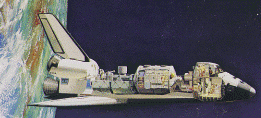|
|
Spacelab 2

Spacelab 2 was flown aboard the Space Shuttle Challenger (STS-51F) from
29 July-6 August 1985. One of the scientific experiments aboard the pallet
was an X-ray telescope (XRT). While the Shuttle failed to get to the intended
orbit because of a premature main engine shutdown, this did not seem to affect
the XRT performance.
XRT was the first orbiting instrument able to make images directly at high
energies. The Spacelab XRT, developed by the University of Birmingham, used a
coded mask technique to make images at energies 2.5-25 keV. The
instrument consisted of 2 co-aligned telescopes mounted together on an alt-
azimuth system carried in the Space Shuttle payload bay. The main elements
of each telescope were a gold coated coded mask in which the opaque elements
occupied ~ 50% of the mask area, supported about 3 m from a position sensitive
proportional counter. The 2 masks had different sized holes, producing
different angular resolutions (3 arcmin and 12 arcmin, FWHM) of the sky. The
higher resolution telescope was used to make detailed studies of the
brighter sources and the other telescope was used to look at fainter
regions of diffuse emission. Each telescope had a field of view of about 6
deg x 6 deg.
Over 75 hours of data were obtained including observations of
8 galactic clusters, the galactic center region, and the Vela SNR.
[Gallery]
[Publications]
[All Missions]
[by Time]
[by Energy]
Page authors: Lorella Angelini Jesse Allen
HEASARC Home |
Observatories |
Archive |
Calibration |
Software |
Tools |
Students/Teachers/Public
Last modified: Thursday, 26-Jun-2003 13:48:17 EDT
|


